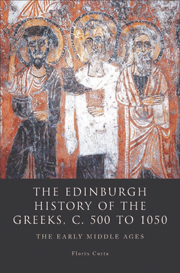Book contents
- Frontmatter
- Contents
- List of Illustrations
- List of Tables
- Acknowledgements
- Series Editor's Preface
- Introduction
- 1 The last century of Roman power (c. 500 to c. 620): army, church, and countryside
- 2 Collapse or adaptation? The problem of the urban decline in late antique Greece
- 3 Invasion or inflation? Hoards and barbarians in sixth- and early seventh-century Greece
- 4 Dark-Age Greece (c. 620 to c. 800)
- 5 Revival and expansion (c. 800 to c. 900)
- 6 The beginning of prosperity (c. 900 to c. 1050)
- 7 Early medieval Greece and the Middle Byzantine economy
- 8 Social structures and Byzantine administration in early medieval Greece
- 9 Christianity in early medieval Greece
- 10 Conclusion: the people of early medieval Greece
- Bibliography
- Index
3 - Invasion or inflation? Hoards and barbarians in sixth- and early seventh-century Greece
Published online by Cambridge University Press: 05 August 2013
- Frontmatter
- Contents
- List of Illustrations
- List of Tables
- Acknowledgements
- Series Editor's Preface
- Introduction
- 1 The last century of Roman power (c. 500 to c. 620): army, church, and countryside
- 2 Collapse or adaptation? The problem of the urban decline in late antique Greece
- 3 Invasion or inflation? Hoards and barbarians in sixth- and early seventh-century Greece
- 4 Dark-Age Greece (c. 620 to c. 800)
- 5 Revival and expansion (c. 800 to c. 900)
- 6 The beginning of prosperity (c. 900 to c. 1050)
- 7 Early medieval Greece and the Middle Byzantine economy
- 8 Social structures and Byzantine administration in early medieval Greece
- 9 Christianity in early medieval Greece
- 10 Conclusion: the people of early medieval Greece
- Bibliography
- Index
Summary
Despite being often accused of having brought the ancient civilisation of Greece to an abrupt end, the Avars and the Slavs have rarely been associated with the destruction of specific cities or monuments (for Avars and Slavs responsible for a wave of destruction throughout Greece, see Weithmann 1985: 103). Shortly after World War II, the Greek historian Dionysios Zakythinos wrote of the Dark Ages separating Antiquity from the Middle Ages as an era of devastation and ruin brought about by the Slavic invaders (Zakythinos 1945: 72 and 1966: 300, 302, and 316; see also Lemerle 1951: 343). Georgios Sotiriou believed that the destruction of basilica A in Thebes was the result of a barbarian invasion, an event ultimately responsible for the settlement in the region of Thebes and Demetrias, around the Bay of Volos, of the Slavic Belegezites (Sotiriou 1929a: 8–9). A French archaeologist attributed the destruction of Corinth and Argos to the Slavic invasion of 586, despite the fact that neither has any such destruction been documented for Corinth, nor is Argos mentioned in any source pertaining to the Slavic and Avar attacks of the 580s (Aupert 1989: 418–19). The absence of any solid evidence of destruction to be attributed to any sixth-century invasion is in sharp contrast to the interest historians have shown in the numismatic evidence, particularly hoards of sixth-century coins. The first to treat coin hoards as a class of evidence pertaining to barbarian invasions was the French numismatist Adrien Blanchet (Blanchet 1900).
- Type
- Chapter
- Information
- The Edinburgh History of the Greeks, c. 500 to 1050The Early Middle Ages, pp. 68 - 96Publisher: Edinburgh University PressPrint publication year: 2011



